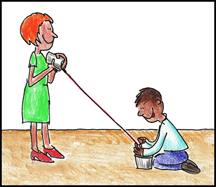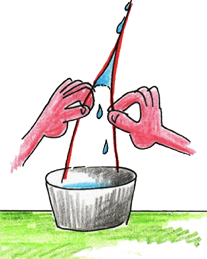It’s 1985 and I’m a “new to science” teacher. The principal and the parents haven’t expected me to teach science, just the basics, so that’s what I’ve been doing. Then a life changing event occurs. Marie came to see me to talk about her son and offered to teach anatomy. Sure, I’m not teaching science, why not let her?
Students who couldn’t pass a spelling test learn how to spell the muscles she was explaining. (Did you know the levator anguli oris, levator labii superioris, orbicularis oculi, risorius, zygomaticus major, and zygomaticus minor make it possible for you to smile?) Students who couldn’t focus in my lessons focus during hers. I become convinced I need to add science to my fourth grade classroom. Students have a reason to learn to read, write, and use math, skills a few of them have struggled to learn.
For me, I know I am bound to make mistakes. Despite practicing before a lesson, I know it won’t always go quite like I expect. My confidence is nonexistent. How do I present science to my students knowing I’m new to science and I’ll definitely mess up?
Fast forward to today and here’s my suggestion for you: mess up on purpose.
Early in the school year, try to look very shocked when a science presentation doesn’t go quite right. The dramatic overreaction suggests the mistake was planned and students will go along to help fix it. So now whenever your presentation doesn’t go as planned, students are sure that’s what you expected so you’re off the hook until you can figure out what went wrong and try the science presentation again.
 Here’s an example to illustrate my point: cohesion activities can be a great way to help a group of students work together as a team and solve minor problems privately. Pouring water down a string is a fun teacher demonstration that can introduce cohesion. If the string is wet, the water seems to magically pour down the string. If the string is dry, the water simply makes a mess as it puddles on the floor.
Here’s an example to illustrate my point: cohesion activities can be a great way to help a group of students work together as a team and solve minor problems privately. Pouring water down a string is a fun teacher demonstration that can introduce cohesion. If the string is wet, the water seems to magically pour down the string. If the string is dry, the water simply makes a mess as it puddles on the floor.
Listen to this audio file of my attempt to pour water down a string that I included in my Cohesion unit for sale through TPT.
You can hear how I “struggle” to pour water down a dry string. It’s like a comedy routine and sets up my students to second guess if I really messed up the demonstration OR if I planned to mess up. In this case, I repeat how to do the activity over and over and then they’re more successful when they get their cups with water and a piece of string.
Whenever students ask a question that I know they could answer by trying out a variation of an experiment, I wink and say “I just don’t know.” They’re sure I know but want them to figure it out on their own. I’m not expected to be a walking science encyclopedia and they’re becoming scientists as they repeat the experiment, with a variation, to find and then share their results.
As a bonus, I’m often surprised by the approaches my students will use that I hadn’t considered. Who puts a portion of their slime in the freezer, then the microwave, and then the freezer just to see what might happen to the slime? Not me, but one of my students recently did just that! I won’t tell you what happened, I’ll let you try it for yourself!!
Do you have other suggestions for building confidence when you teach science?


I love the “dramatic overreaction” method of dealing with lessons not going as planned. As long as the students think it is all part of the plan, it is no problem! When I was a substitute teacher, I would do this all of the time. 6th grade math is hard and I would always act like I knew what to do, but I would have the one student in the class who is always on top of it come up and work out the problem. Then I would say, “see, just like that”. Sometimes you have to put on a show!
A good teacher, like a good entertainer, first must hold his audience’s attention, then he can teach his lesson -John Henrik Clarke